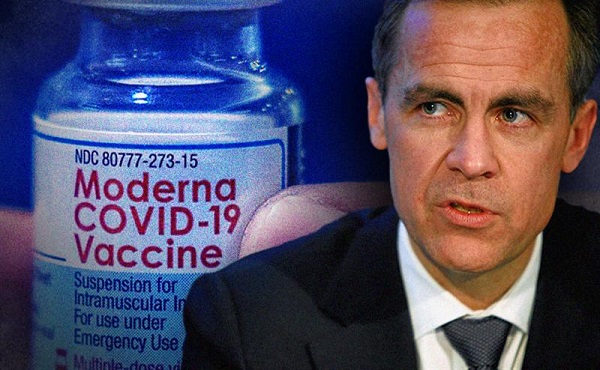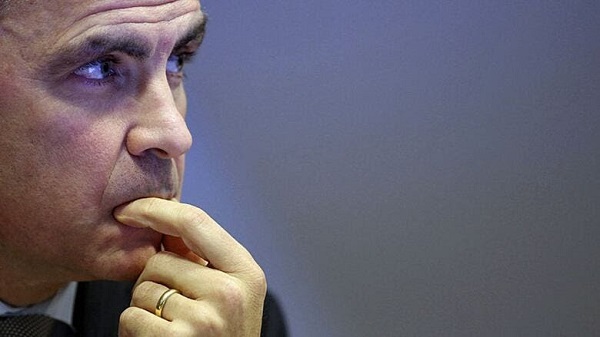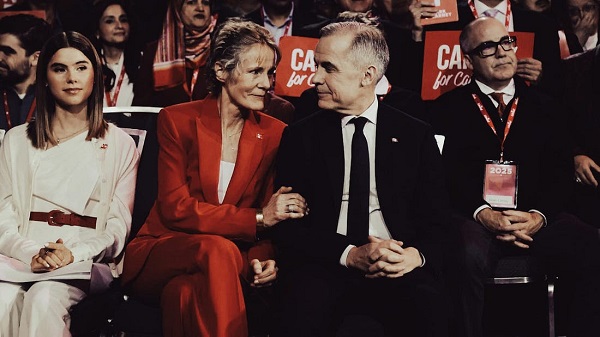Business
Mark Carney’s Misleading Actions and Non-Disclosure Should Disqualify Him as Canada’s Next Truly “Elected” Prime Minister – Jim Warren

From EnergyNow.Ca
By Jim Warren
If Mark Carney simply told the truth, he wouldn’t have to remember if what he says in Quebec matches what he says in Western Canada.
When speaking in Kelowna on February 12, Mark Carney left the impression he’d been converted from environmental zealot to missionary for an Energy East pipeline.
Carney said he would “use all of the powers of the federal government, including the emergency powers of the federal government, to accelerate the major projects that we need in order to build this economy and take on the Americans.”
Five days later Carney told CBC those emergency powers wouldn’t apply to Quebec. The government of Quebec would have veto power over any pipeline to the east coast. To clear up any possible confusion he repeated his pipeline veto pledge to Quebec at the French debate for the Liberal Leadership.
Apparently tough measures like the “peace, order and good government” clause in the Constitution and the Emergencies Act can be used by Liberals to arrest and seize the bank accounts of truckers who honk horns and cause traffic jams in Ottawa. But they can’t be used to build pipelines across Quebec even if it will reduce the impact of US tariffs on Canada’s economy. Like any good Liberal, Carney knows the interests of Maritimers and the West are of little consequence when his party needs to boost its support in Quebec.
Ironically, the second national poll in the past few months shows a majority of Quebecers support the construction of an East/West pipeline through their province. It is the Central Canadian political elite based in the major cities of Ontario and Quebec and excessively zealous environmental activists who oppose pipelines. And the Liberals are, of course, the party which represents that environmentally sanctimonious elite.
You read it here first.
On January 28, EnergyNow ran a column with the headline: Trump’s Wake-up Call to Canada, Politicians & Activists… The column outlined how the “peace, order and good government’” clause in the Constitution and/or the Emergencies Act could be employed to override regulatory barriers and court injunctions to ensure new pipelines to tidewater are built. The column says the first step in that process will be booting the Liberals from office. That condition still applies, given that Carney’s one-time mention of using “emergency powers” in support of a West to East pipeline turned out to be just one more Liberal lie to Western Canada.
Pierre Poilievre has aptly pegged Mark Carney as a hypocrite whose corporate interests and behavior are in substantial conflict with his environmental virtue signaling. At a House of Commons committee hearing in 2021, Poilievre spanked Carney for supporting the cancellation of the Energy East pipeline, while Brookfield Asset Management, the company he chaired, had bought pipelines in Brazil and the United Arab Emirates.
Poilievre admonished Carney, “You make billions of dollars off foreign pipelines and you shut them down here at home, putting our people out of work.”
More recently Carney misled Canadians about the role he played in moving Brookfield’s head office from Canada to the US. Carney claimed he had absolutely nothing to do with the move despite the fact he was company chairman at the time.
No less egregious is the fact Carney has used a loophole in federal legislation to avoid the financial disclosure rules for cabinet ministers including the prime minister. The disclosure rules help Parliament determine when ministers are involved in conflicts of interest. Carney will soon be crowned prime minister by the Liberals and will technically be exempt from the rule.
Carney is technically exempt because he’s never been elected as an MP. He will be able to avoid making his financial disclosure until 60 days after he is appointed prime minster. This means there is a good chance Carney’s financial information won’t be available well into the run up to a possible spring election.
Poilievre rang the alarm regarding the loophole and plans to introduce legislation as soon as Parliament reopens to fix the problem. He pointed out that there was nothing preventing Carney from being transparent and voluntarily providing the necessary information to Canadians prior to the Liberal leadership vote.
Poilevre was being too kind. A lack of integrity is what’s holding Carney back.
Carney is on record as a firm believer in carbon taxes. In the book he published in 2023 he wrote, “Meaningful carbon prices are the cornerstone of any effective [environmental] policy framework.”
Now, in support of his campaign to become prime minister, Carney promises to get rid of Canada’s unpopular carbon tax. The claim is clearly deceptive. He intends to replace the current tax on consumers with an upstream tax on oil producers and industry. Carney must think Canadians are too dumb to realize the increased upstream tax burden will be passed on to consumers in the form of higher prices for virtually everything they purchase.
When Carney is pressed to explain his carbon tax 2.0, he mumbles his way through an incomprehensible word salad worthy of Kamala Harris.
Also like Harris, Carney avoids campaign events where non-supporters might show up or media appearances and interviews where he might be asked a tough question. His appearance on US late night talk shows hosted by uber-liberals like Jon Stewart are unlikely to generate hard ball questions—the hosts are ignorant about Canadian politics and wouldn’t have a clue about what to ask.
I think Carney knows how bad the Kamala campaign tactics look. He was clearly taken aback by an incident at a campaign event in Regina. A member of the Liberal party who was somehow identified as a closet Conservative was accosted by two security agents and police who ejected him from the meeting. The guy had done nothing untoward—he hadn’t so much as raised his voice. It seems Mark Carney is very precious and must be protected from the public– including Liberal party members who are potentially dangerous because they supported another party in the past.
Where Carney really stands on environmental issues
Mark Carney didn’t just drink the climate alarmist Kool-Aid, he helped make it and wants to serve it to you.
“He’s the father of net-zero on a global basis,” according to Catherine Swift, President of the Canadian Coalition of Concerned Manufacturers and Businesses of Canada.
Carney has been a steadfast supporter of the environmental dogma underlying the Liberal assault on the fortunes of the oil and gas industries including the legislation preventing new pipelines. For years now, he’s been working on the inside of international organizations dedicated to climate change mitigation and greenhouse gas (GHG) emissions reduction.
In December 2019, he was appointed as the very first UN Special Envoy for Climate Action and Finance.
Prior to, during and after his time at the UN Carney has found time to hobnob with the billionaires and national leaders who presumably constitute the global elite. He’s been a regular at the annual World Economic Forum conferences in Davos, Switzerland.
As a member of the forum’s Foundation Board he is a duly qualified member of the modern day Illuminati. He associates with the international bankers who presume to know what’s best for the little people. His promotion of the radical green agenda dovetails nicely with the environmental virtue signaling of the world’s rich and powerful at Davos. They are dedicated to conquering global warming no matter what it costs the rest of us.
At the COP26 conference in 2021 Carney proudly proclaimed he was part of the same social movement as Greta Thunberg. Carney praised Thunberg as the “catalyst” who inspired the youth wing of the environmental movement. I haven’t heard if he’s gone off Greta and her wing of the movement now that she has announced her support for Hamas.
Don Braid recently wrote an insightful column in the Calgary Herald where he proposes that Carney is too deeply embedded in environmental activism and too publicly committed to climate change mitigation and the anti-oil agenda to run away from it when he becomes prime minister. Braid reports what Carney had to say about the environment and the need to abandon natural gas and petroleum in the 600 page door-stopper book he published in 2021, Value(s): Building a Better World for All.
In 2021, Carney was deluded enough to imagine the world’s virtuous emissions cutters would prevent the planet’s average temperature in 2050 from being any higher than 1.5O above what it was in the middle of the 19th century.
Not even serious climate change alarmists like Gwynne Dyer believe that’s remotely possible. The goals of climate zealots like Carney include fanciful, overly ambitious emissions reduction targets. They want change to happen too fast to be affordable for virtually everyone except the sorts of people who hang out at Davos.
In his book, Carney identifies what he believes should happen to the fossil fuel industries. His goals don’t bode well for the future of Canada’s petroleum and gas sectors and can’t help but harm the country’s economy.
Carney writes, “To meet the 1.5o C target, more than 80 per cent of current fossil fuel reserves (including three-quarters of coal, half of gas, one-third of oil)” will need to “stay in the ground, stranding these assets.”
Steven Guilbeault, Canada’s most infamous and politically dangerous environmental extremist backed Carney in the Liberal leadership contest. Guilbeault’s support is in recognition of Carney’s radical record on environmental issues including climate change mitigation.
Nothing to say about Liberal corruption
One of the most disturbing omissions from Carney’s political platform and media coverage of his campaign is any mention of plans for dealing with runaway Liberal cronyism and corruption.
He hasn’t promised to open the books and jail the crooks. He hasn’t promised to release the unredacted evidence of Green Slush Fund corruption. He hasn’t promised to release that evidence and turn it over to Parliament and the RCMP. He hasn’t announced plans for a thorough forensic accounting of Liberal backroom deals. And he hasn’t promised investigations into sweetheart contracts and looting in cases like the ArriveCAN scam.
He can’t do any of the above because it would implicate a number of Liberal insiders and he needed them to support him in the leadership contest. And how will he be able to work with the government caucus if he suggests he wants to get tough with the hogs at the trough? Given that he won’t release his financial information, it could be he doesn’t want to limit his own access to the gravy train.
In the final analysis, you’d have to say Mark Carney is a committed environmental zealot except when it interferes with his business interests or political ambitions.
He appears comfortable giving preference to the environmental extremism of the Davos set over the harm overly zealous climate change policies do to the livelihoods of ordinary Canadians and the country’s economy.
He appears comfortable with hypocrisy and misleading Canadians which clearly qualifies him to lead the Liberal party, but makes for a bad prime minister.
Business
Carney Liberals quietly award Pfizer, Moderna nearly $400 million for new COVID shot contracts

From LifeSiteNews
Carney’s Liberal government signed nearly $400 million in contracts with Pfizer and Moderna for COVID shots, despite halted booster programs and ongoing delays in compensating Canadians for jab injuries.
Prime Minister Mark Carney has awarded Pfizer and Moderna nearly $400 million in new COVID shot contracts.
On June 30th, the Liberal government quietly signed nearly $400 million contracts with vaccine companies Pfizer and Moderna for COVID jabs, despite thousands of Canadians waiting to receive compensation for COVID shot injuries.
The contracts, published on the Government of Canada website, run from June 30, 2025, until March 31, 2026. Under the contracts, taxpayers must pay $199,907,418.00 to both companies for their COVID shots.
Notably, there have been no press releases regarding the contracts on the Government of Canada website nor from Carney’s official office.
Additionally, the contracts were signed after most Canadians provinces halted their COVID booster shot programs. At the same time, many Canadians are still waiting to receive compensation from COVID shot injuries.
Canada’s Vaccine Injury Support Program (VISP) was launched in December 2020 after the Canadian government gave vaccine makers a shield from liability regarding COVID-19 jab-related injuries.
There has been a total of 3,317 claims received, of which only 234 have received payments. In December, the Canadian Department of Health warned that COVID shot injury payouts will exceed the $75 million budget.
The December memo is the last public update that Canadians have received regarding the cost of the program. However, private investigations have revealed that much of the funding is going in the pockets of administrators, not injured Canadians.
A July report by Global News discovered that Oxaro Inc., the consulting company overseeing the VISP, has received $50.6 million. Of that fund, $33.7 million has been spent on administrative costs, compared to only $16.9 million going to vaccine injured Canadians.
Furthermore, the claims do not represent the total number of Canadians injured by the allegedly “safe and effective” COVID shots, as inside memos have revealed that the Public Health Agency of Canada (PHAC) officials neglected to report all adverse effects from COVID jabs and even went as far as telling staff not to report all events.
The PHAC’s downplaying of jab injuries is of little surprise to Canadians, as a 2023 secret memo revealed that the federal government purposefully hid adverse effect so as not to alarm Canadians.
The secret memo from former Prime Minister Justin Trudeau’s Privy Council Office noted that COVID jab injuries and even deaths “have the potential to shake public confidence.”
“Adverse effects following immunization, news reports and the government’s response to them have the potential to shake public confidence in the COVID-19 vaccination rollout,” read a part of the memo titled “Testing Behaviourally Informed Messaging in Response to Severe Adverse Events Following Immunization.”
Instead of alerting the public, the secret memo suggested developing “winning communication strategies” to ensure the public did not lose confidence in the experimental injections.
Since the start of the COVID crisis, official data shows that the virus has been listed as the cause of death for less than 20 children in Canada under age 15. This is out of six million children in the age group.
The COVID jabs approved in Canada have also been associated with severe side effects, such as blood clots, rashes, miscarriages, and even heart attacks in young, healthy men.
Additionally, a recent study done by researchers with Canada-based Correlation Research in the Public Interest showed that 17 countries have found a “definite causal link” between peaks in all-cause mortality and the fast rollouts of the COVID shots, as well as boosters.
Interestingly, while the Department of Health has spent $16 million on injury payouts, the Liberal government spent $54 million COVID propaganda promoting the shot to young Canadians.
The Public Health Agency of Canada especially targeted young Canadians ages 18-24 because they “may play down the seriousness of the situation.”
Business
Carney government should apply lessons from 1990s in spending review

From the Fraser Institute
By Jake Fuss and Grady Munro
For the summer leading up to the 2025 fall budget, the Carney government has launched a federal spending review aimed at finding savings that will help pay for recent major policy announcements. While this appears to be a step in the right direction, lessons from the past suggest the government must be more ambitious in its review to overcome the fiscal challenges facing Canada.
In two letters sent to federal cabinet ministers, Finance Minister François-Philippe Champagne outlined plans for a “Comprehensive Expenditure Review” that will see ministers evaluate spending programs in each of their portfolios based on the following: whether they are “meeting their objectives” are “core to the federal mandate” and “complement vs. duplicate what is offered elsewhere by the federal government or by other levels of government.” Ultimately, as a result of this review, ministers are expected to find savings of 7.5 per cent in 2026/27, rising to 10 per cent the following year, and reaching 15 per cent by 2028/29.
This news comes after the federal government has recently made several major policy announcements that will significantly impact the bottom line. Most notably, the government added an additional $9.3 billion to the defence budget for this fiscal year, and committed to more than double the annual defence budget by 2035. Without any policies to offset the fiscal impact of this higher defence spending (along with other recent changes), this year’s budget deficit (which the Liberal’s election platform initially pegged at $62.3 billion) will likely surpass $70.0 billion, and potentially may reach as high as $92.2 billion.
A spending review is long overdue. Recent research suggests that each year the federal government spends billions towards programs that are inefficient and/or ineffective, and which should be eliminated to find savings. Moreover, past governments (both federal and provincial) have proven that fiscal adjustments based on spending reviews can be very successful—just look at the Chrétien government’s 1995 Program Review.
In its 1995 budget, the federal Chrétien government launched a comprehensive review of all federal spending that—along with several minor tax increases—ultimately balanced the federal budget in two years and helped Canada avert a fiscal crisis. Two aspects of this review were critical to its success: it reviewed all federal spending initiatives with no exceptions, and it was based on clear criteria that not only tested whether spending was efficient, but which also reassessed the federal government’s role in delivering programs and services to Canadians. Unfortunately, the Carney government’s review is missing these two critical aspects.
The Carney government already plans to exclude large swathes of the budget from its spending review. While it might be reasonable for the government to exclude defence spending given our recent commitments (though that doesn’t appear to be the plan), the Carney government has instead chosen to exclude all transfers to individuals (such as seniors’ benefits) and provinces (such as health-care spending) from any spending cuts. Based on the last official spending estimates for this year, these two areas alone represent a combined $254.6 billion—or more than half of total spending after excluding debt charges—that won’t be reviewed.
This is a major weakness in the government’s plan. Not only does this limit the dollar value of savings available, it also means a significant portion of the government’s budget is missing out on a reassessment that could lead to more effective delivery of services for Canadians.
For example, as part of the 1995 program review, the Chrétien government overhauled how it delivered welfare transfers to provincial governments. Specifically, the federal government replaced two previous programs with a new Canada Health and Social Transfer (CHST) that addressed some major flaws with how the government delivered welfare assistance. While the transition to the CHST did include a $4.6 billion reduction in spending on government transfers, the new structure gave the federal government better control over spending growth in the future and allowed provincial governments more flexibility to tailor social assistance programs to local needs and preferences.
In addition to considering all areas of spending, the Carney government’s spending review also needs to be more ambitious in its criteria. While the current criteria are an important start—for example, it’s critical the government identifies and eliminates spending programs that aren’t achieving their stated objectives or which are simply duplicating another program—the Carney government should take it one step further and explicitly reflect on the role of the federal government itself.
Among other criteria that focused on efficiency and affordability of programs, the 1995 program review also evaluated every spending program based on whether government intervention was even necessary, and whether or not the federal government specifically should be involved. As such, not only did the program review eliminate costly inefficiencies, it also included the privatization of government-owned entities such as Petro-Canada and Canadian National Railway—which generated considerable economic benefits for Canadians.
Today, the federal government devotes considerable amounts of spending each year towards areas that are outside of its jurisdiction and/or which government shouldn’t be involved in the first place—national pharmacare, national dental care, and national daycare all being prime examples. Ignoring the fact that many of these areas (including the three examples) are already excluded from the Carney government’s spending review, the government’s criteria makes no explicit effort to test whether a program is targeting an area that’s outside of the federal purview.
For instance, while the government will test whether or not a spending program fits within the federal mandate, that mandate will not actually ensure the government stays within its own jurisdictional lane. Instead, the mandate simply lays out the key priorities the Carney government intends to focus on—including vague goals including, “Bringing down costs for Canadians and helping them to get ahead” which could be used to justify considerable federal overreach. Similarly, the government’s other criterion to not duplicate programs offered by other levels of government provides little meaningful restriction on government spending that is outside of its jurisdiction so long as that spending can be viewed as “complementing” provincial efforts. In other words, this spending review is unlikely to meaningfully check the costly growth in the size of government that Canada has experienced over the last decade.
Simply put, the Carney government’s spending review, while a step in the right direction, is missing key elements that will limit its effectiveness. Applying key lessons from the Chrétien government’s spending review is crucial for success today.
Grady Munro
Policy Analyst, Fraser Institute
-

 Fraser Institute1 day ago
Fraser Institute1 day agoBefore Trudeau average annual immigration was 617,800. Under Trudeau number skyrocketted to 1.4 million annually
-

 MAiD1 day ago
MAiD1 day agoCanada’s euthanasia regime is already killing the disabled. It’s about to get worse
-

 Frontier Centre for Public Policy1 day ago
Frontier Centre for Public Policy1 day agoNew Book Warns The Decline In Marriage Comes At A High Cost
-

 Business1 day ago
Business1 day agoPrime minister can make good on campaign promise by reforming Canada Health Act
-

 Addictions1 day ago
Addictions1 day ago‘Over and over until they die’: Drug crisis pushes first responders to the brink
-

 International1 day ago
International1 day agoChicago suburb purchases childhood home of Pope Leo XIV
-

 Daily Caller1 day ago
Daily Caller1 day agoUSAID Quietly Sent Thousands Of Viruses To Chinese Military-Linked Biolab
-

 Business2 days ago
Business2 days ago103 Conflicts and Counting Unprecedented Ethics Web of Prime Minister Mark Carney





